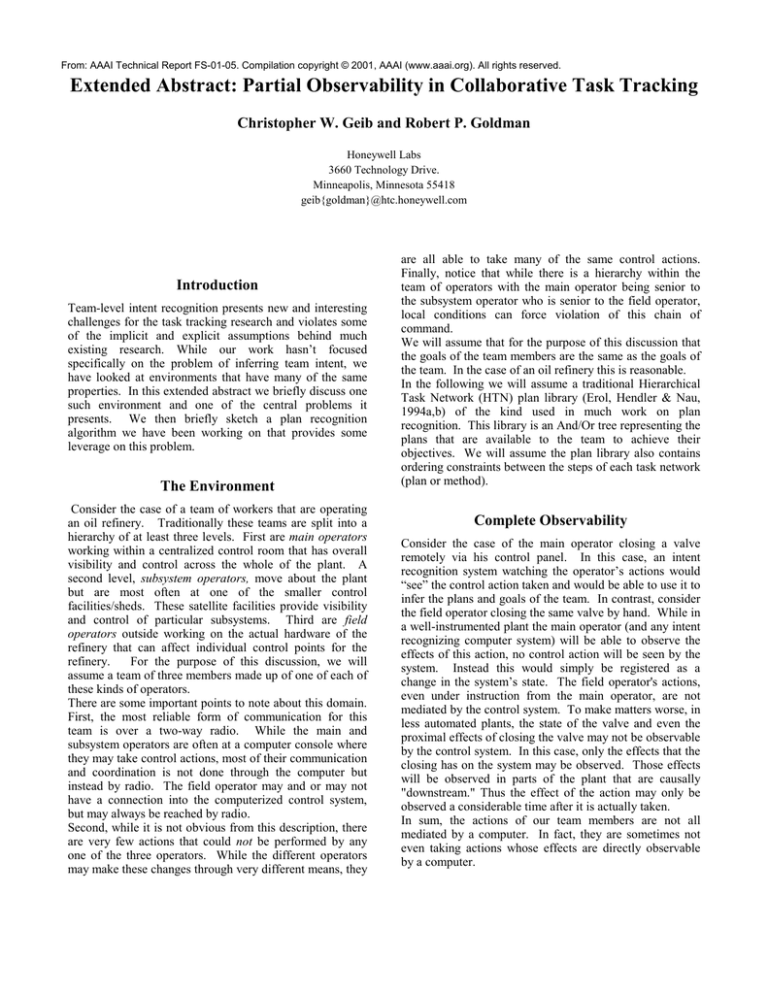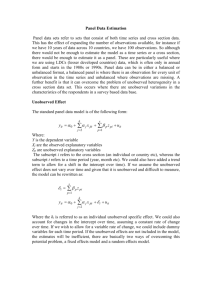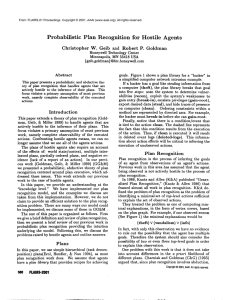
From: AAAI Technical Report FS-01-05. Compilation copyright © 2001, AAAI (www.aaai.org). All rights reserved.
Extended Abstract: Partial Observability in Collaborative Task Tracking
Christopher W. Geib and Robert P. Goldman
Honeywell Labs
3660 Technology Drive.
Minneapolis, Minnesota 55418
geib{goldman}@htc.honeywell.com
Introduction
Team-level intent recognition presents new and interesting
challenges for the task tracking research and violates some
of the implicit and explicit assumptions behind much
existing research. While our work hasn’t focused
specifically on the problem of inferring team intent, we
have looked at environments that have many of the same
properties. In this extended abstract we briefly discuss one
such environment and one of the central problems it
presents. We then briefly sketch a plan recognition
algorithm we have been working on that provides some
leverage on this problem.
The Environment
Consider the case of a team of workers that are operating
an oil refinery. Traditionally these teams are split into a
hierarchy of at least three levels. First are main operators
working within a centralized control room that has overall
visibility and control across the whole of the plant. A
second level, subsystem operators, move about the plant
but are most often at one of the smaller control
facilities/sheds. These satellite facilities provide visibility
and control of particular subsystems. Third are field
operators outside working on the actual hardware of the
refinery that can affect individual control points for the
refinery.
For the purpose of this discussion, we will
assume a team of three members made up of one of each of
these kinds of operators.
There are some important points to note about this domain.
First, the most reliable form of communication for this
team is over a two-way radio. While the main and
subsystem operators are often at a computer console where
they may take control actions, most of their communication
and coordination is not done through the computer but
instead by radio. The field operator may and or may not
have a connection into the computerized control system,
but may always be reached by radio.
Second, while it is not obvious from this description, there
are very few actions that could not be performed by any
one of the three operators. While the different operators
may make these changes through very different means, they
are all able to take many of the same control actions.
Finally, notice that while there is a hierarchy within the
team of operators with the main operator being senior to
the subsystem operator who is senior to the field operator,
local conditions can force violation of this chain of
command.
We will assume that for the purpose of this discussion that
the goals of the team members are the same as the goals of
the team. In the case of an oil refinery this is reasonable.
In the following we will assume a traditional Hierarchical
Task Network (HTN) plan library (Erol, Hendler & Nau,
1994a,b) of the kind used in much work on plan
recognition. This library is an And/Or tree representing the
plans that are available to the team to achieve their
objectives. We will assume the plan library also contains
ordering constraints between the steps of each task network
(plan or method).
Complete Observability
Consider the case of the main operator closing a valve
remotely via his control panel. In this case, an intent
recognition system watching the operator’s actions would
“see” the control action taken and would be able to use it to
infer the plans and goals of the team. In contrast, consider
the field operator closing the same valve by hand. While in
a well-instrumented plant the main operator (and any intent
recognizing computer system) will be able to observe the
effects of this action, no control action will be seen by the
system. Instead this would simply be registered as a
change in the system’s state. The field operator's actions,
even under instruction from the main operator, are not
mediated by the control system. To make matters worse, in
less automated plants, the state of the valve and even the
proximal effects of closing the valve may not be observable
by the control system. In this case, only the effects that the
closing has on the system may be observed. Those effects
will be observed in parts of the plant that are causally
"downstream." Thus the effect of the action may only be
observed a considerable time after it is actually taken.
In sum, the actions of our team members are not all
mediated by a computer. In fact, they are sometimes not
even taking actions whose effects are directly observable
by a computer.
We can no longer assume that a complete set of
observations of the important actions will be available as
input. In this domain, and other team based domains, it is
critical to infer the execution of actions that are not directly
observed but are implied by other observations. In our
previous work (Geib and Goldman 2001a) we have
identified two kinds of information that provide us grounds
to infer the execution of unobserved actions: the
observation of unenabled actions, and observations of state
changes.
We define an unenabled action as an observed action
whose preconditions (as given in the ordering constraints of
the plan graph) have not been observed prior to the
observation of the action. The plan graph has ordering
constraints between the observed action and one or more
actions (more generally, subgoals) that have not been
observed. If we assume the plan library is a complete
representation of the team’s available plans, the execution
of such an unenabled action gives us good reason to believe
the enabling actions must have been performed without
being observed.
Observations of state changes provide similar evidence for
unobserved actions. If our representation of actions
includes the effects of the action, we can use reports of
state changes to infer the occurrence of unobserved actions.
In particular, we can hypothesize the occurrence of actions
that could cause the state changes. Observations of state
changes have not played a part in previous plan recognition
work. The loss of a complete observability makes it
critical to include this information stream.
In our previous work (Goldman, Geib & Miller, 1999, Geib
and Goldman, 2001a 2001b), we have put forward a theory
and implementation of plan recognition that handles the
issues of partial observability. We discuss this approach in
the following section.
Our Approach
Our plan recognition framework PHATT (Probabilistic
Hostile Agent Task Tracker) is based on the realization that
plans are executed dynamically and that at any given
moment the agent is able to choose to execute any of the
actions that have been enabled by its previous actions. To
formalize this slightly, initially the executing agent has a set
of goals and chooses a set of plans to execute to achieve
these goals. The set of plans chosen determines the set of
pending primitive actions. As the episode proceeds, the
agent will repeatedly execute one of the pending actions,
and generate a new set of pending actions from which
further actions will be chosen.
The new pending set is generated from the previous set by
removing the action just executed and adding newly
enabled actions. Actions become enabled when their
required predecessors are completed. This process is
illustrated in Figure 1. To provide some intuition for the
probabilistically-inclined, the sequence of pending sets can
be seen as a Markov chain, and the addition of the action
executions with unobserved actions makes it a hidden
Markov model.
Figure 1: A simple model of pending set generation
This view of plan execution provides a simple conceptual
model for the generation of execution traces. To use this
model to perform probabilistic plan recognition, we use the
observations of the agent's actions as an execution trace. By
stepping forward through the trace, and hypothesizing
goals the agent may have, we can generate the agent's
resulting pending sets. Once we have reached the end of the
execution trace we will have the complete set of pending
sets that are consistent with the observed actions and the
sets of hypothesized goals that go with each of these sets.
Once we have this set, we establish a probability
distribution over it. We can then determine which of the
possible goals the agent is most likely pursuing.
Notice that observations of the agent's actions are used to
construct the execution traces. As we have pointed out, in
cases of team intent recognition, the observations will not,
in general, be a complete record of the execution trace.
Instead it will be necessary to consider execution traces
containing unobserved actions. For each set of observations
we must construct a set of possible execution traces,
inserting hypothesized unobserved actions to complete
them.
Since any of the actions in the agent's pending set could be
added to the hypothesized execution trace, this process
results in a significant expansion of the search space. This
space can be pruned using ordering constraints provided by
the observations. We need only consider execution traces
that are consistent with the observation stream. Therefore,
we reject sequences that do not contain all the observed
actions, and those in which actions appear in different
order. As we will see, the execution traces are also filtered
to be consistent with the unobserved actions that are
implied by unenabled actions and observed state changes.
Inferring Unobserved actions
Beyond the completely observable cases we have discussed
so far, PHATT is designed to infer the goals of an agent
given that his/her behavior is only partially observable.
The central idea behind this work is the production of a
probability distribution over the set of all pending sets.
This is generated using the observations as an execution
trace of the agent's actions. Since each pending set
represents the results of at least one execution trace, we
generated the pending sets by stepping through
observations.
In the case of complete and correct
observations, this is sufficient. However, in the case of
only partially observed action sequences, the observation
stream no longer represents the complete execution trace.
Instead, for each set of observations we must construct a
set of possible execution traces, inserting hypothesized
unobserved actions to complete them.
Since any of the actions in the agent's pending set could be
added to the hypothesized execution trace, this process
results in a significant expansion of the search space. This
space can be pruned using ordering constraints provided by
the observations. We are only interested in execution
traces consistent with the observations. Therefore, if a
sequence does not contain all the observed actions or
doesn't obey the ordering constraints imposed by the
sequence or plan library, it cannot generate one of the
pending sets we are interested in and can be filtered from
consideration. The execution traces are also filtered to be
consistent with the unobserved actions that are implied by
unenabled actions and observed state changes.
To summarize, we handle unobserved actions by extending
the observed sequence of actions with hypothesized
unobserved actions consistent with the observed actions,
observed state changes, and the plan graph to create a set of
possible execution traces. Then we follow the plan
recognition algorithm as before. We use the set of
execution traces to construct the pending sets and then the
probability distribution over the sets of hypotheses of goals
and plans implicated by each of the traces and pending sets.
Bounding the number of
unobserved actions
The algorithm that we have sketched does not provide a
mechanism for determining when to stop hypothesizing
unobserved actions. As it stands this algorithm will
generate and infinite stream of explanations of ever
increasing length. To know when to stop adding actions to
the explanations we compute the likelihood that various
actions have been executed and were not observed.
Not all actions are equally likely to be executed without
detection. Some actions are harder to hide than others. For
example, the probability that a person could make a small
change in the amount of air entering one of the refinery’s
subsystems undetected is much higher than the probability
that they could successfully shut down the entire refinery
unnoticed.
By capturing the probability that an action can be executed
without observation, it is possible for our algorithm to
generate the probability of a sequence of actions being
executed unobserved. However, computing the probability
of the unobserved actions in the execution trace is only half
of the solution. We must also bound the probability of the
unobserved actions within an explanation that we are
willing to accept.
If no threshold were placed on the likelihood of the
unobserved actions, the process of inferring actions would
proceed to successively more and more unlikely
explanations by adding more and more unobserved actions.
To prevent the generation of this infinite sequence of ever
less likely explanations, we require that the user provide a
threshold probability value for the unobserved actions. We
then build the explanation traces and compute the
likelihood of the unobserved actions being executed
unnoticed. If the addition of an unobserved action would
drop the probability that the set of unobserved actions
were executed unnoticed below the user's threshold, the
explanation is not considered.
Assumptions
In our implementation of this algorithm we have assumed
the given observations are true and correctly ordered. Thus
if we have a sequence of three observations: a, b, c, we
know a happened before b, which happened before c.
We also assume we need not question the validity of
observations. However, there are environments where this
assumption must be questioned. Consider a military
example, if we receive a report of troops massing at a
particular location, we must first determine the validity of
the report before considering the effect this would have on
our assessment of the enemy's goals. It is straightforward
to complicate the model by including a traditional model of
noisy observations.
Summary
We handle unobserved actions by extending the observed
sequence of actions with hypothesized unobserved actions
consistent with the observed actions, observed state
changes, and the plan graph to create a set of possible
execution traces. Then we follow the plan recognition
algorithm as before. We use the set of execution traces to
construct the pending sets and then the probability
distribution over the sets of hypotheses of goals and plans
implicated by each of the traces and pending sets.
To prevent the generation of an infinite sequence of ever
less likely explanations, we also require two things. First,
we compute the probability that the unobserved actions in
the sequence could actually be performed without being
observed. Second, we bound the probability of the
explanations that we are willing to accept for our execution
traces. In effect, we extend our algorithm to allow the user
to specify how unlikely an explanation they are willing to
accept and then use this bound to limit the unobserved
actions that are added to the execution trace.
This approach has the added benefit that unobserved
actions are added relative to the likelihood of their being
executed unobserved. So, for example, small short term
fluctuations in temperature, that don’t disturb the process,
might be inserted in an execution trace while the loss of a
primary feed pump, or the loss of input oxygen, that is easy
to observe, cannot be added to the trace. We refer the
interested reader to (Geib & Goldman, 2001a,b) for a more
complete discussion of these issues.
References
Kutluhan Erol, K., Hendler, J. and Nau, D.S., "UMCP: A
Sound and Complete Procedure for Hierarchical Task
Network Planning,” Artificial Intelligence Planning
Systems: Proceedings of the Second International
Conference (AIPS-94), Chicago, 1994.
Kutluhan Erol, K., Hendler, J. and Nau, D.S., "HTN
Planning: Complexity and Expressivity,” Artificial
Intelligence Planning Systems: Proceedings of the Second
International Conference (AIPS-94), Chicago, 1994.
Geib, C.W., and Goldman, R.P., “Probabilistic Plan
Recognition for Hostile Agents,” Proceedings of the
FLAIRS01 Conference, Key West, 2001a.
Geib, C.W. and Goldman, R.P., “Plan Recognition in
Intrusion Detection Systems,” Proceedings of the DISCEXII Conference, 2001b.
Goldman, R.P., Geib, C.W., and Miller, C.A., “A New
Model of Plan Recognition,” In Proceedings of the 1999
Conference on Uncertainty in Artificial Intelligence,
Stockholm, 1999.




